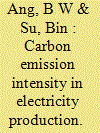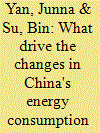| Srl | Item |
| 1 |
ID:
150669


|
|
|
|
|
| Summary/Abstract |
We study changes in the aggregate carbon intensity (ACI) for electricity at the global and country levels. The ACI is defined as the energy-related CO2 emissions in electricity production divided by the electricity produced. It is a performance indicator since a decrease in its value is a desirable outcome from the environmental and climate change viewpoints. From 1990 to 2013, the ACI computed at the global level decreased only marginally. However, fairly substantial decreases were observed in many countries. This apparent anomaly arises from a geographical shift in global electricity production with countries having a high ACI increasingly taking up a larger electricity production share. It is found that globally and in most major electricity producing countries, reduction in their ACI was due mainly to improvements in the thermal efficiency of electricity generation rather than to fuel switching. Estimates of the above-mentioned effects are made using LMDI decomposition analysis. Our study reveals several challenges in reducing global CO2 emissions from the electricity production sector although technically the reduction potential for the sector is known to be great.
|
|
|
|
|
|
|
|
|
|
|
|
|
|
|
|
| 2 |
ID:
183087


|
|
|
|
|
| Summary/Abstract |
Singapore is a small island-state and meticulously planned city. The lack of energy resources has underpinned its unwavering focus on energy efficiency. Yet to date it is unclear to what extent energy efficiency, or the so-called “hidden fuel” or “invisible fuel”, has contributed to reductions in its energy consumption. Using a comprehensive and unique set of energy and sectoral activity data, this study applies the energy intensity concept and index decomposition analysis technique to study the role of energy efficiency in reducing Singapore's energy consumption from 2005 to 2018. The results obtained show variations across energy consuming sectors, but overall energy efficiency has led to significant energy savings. A composite energy efficiency index is also constructed to quantify the extent of energy efficiency improvement economy-wide over time. The performance as captured by this index shows a slower rate of improvement as compared to that given by the reduction in Singapore's aggregate energy-to-GDP ratio. This development is similar to that observed in most OECD countries. The framework developed can be applied to the study of other major cities especially those in Southeast Asia. It should be noted that, while the approach used has been widely accepted in the energy efficiency literature, the energy efficiency trends derived are dependent on the activity indicators chosen to represent the useful work performed in the respective sectors. The results should therefore be interpreted in this context.
|
|
|
|
|
|
|
|
|
|
|
|
|
|
|
|
| 3 |
ID:
176740


|
|
|
|
|
| Summary/Abstract |
During the 12th Five-Year Plan Period (2011–2015), the Chinese government has released a series of energy conservation plans to launch and deepen the transition in the energy use. Particularly, the dual control of the energy consumption and energy intensity was firstly emphasized. This paper intends to explore the targeted and effective energy policy implications through investigating the drivers of changes in energy consumption/intensity of China during the 12th Five-Year Plan Period. Under the input-output framework, the embodied energy consumptions/intensities by final demand category were estimated at aggregate/sector level and the total energy consumption/intensity was decomposed using the additive/multiplicative structural decomposition analysis. Among the final demand categories, China's energy consumption/intensity was mainly contributed by the investment, followed by the household consumption. According to the SDA results, China's total energy consumption increased by 28.8%, of which the energy intensity effect and the investment effect were the most retardant and accelerator, respectively. At the same time, China's total aggregate energy intensity decreased by 16.0%, of which the energy intensity effect and the household consumption effect were the most retardant and accelerator, respectively. In detail, the key sectors with respect to the critical effects were picked out. Above all, policy implications are discussed for achieving the energy goals during the 13th Five-Year Plan Period and launching the energy revolution during the 14th Five-Year Plan Period.
|
|
|
|
|
|
|
|
|
|
|
|
|
|
|
|